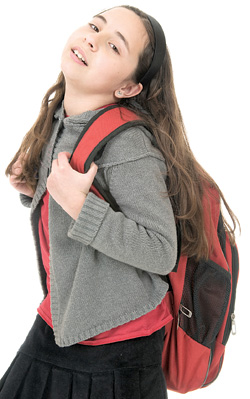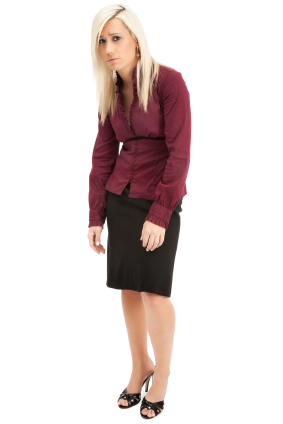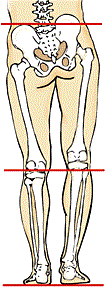

Scoliosis affects approximately 4% of of the population. These scoliosis cases fall into two groups: Nonstructural Scoliosis and Structural Scoliosis. To determine what causes scoliosis, you must first determine what type of scoliosis.
Nonstructural vs Functional Cause of Scoliosis
This type of scoliosis is caused by a temporary condition and the spine is otherwise normal. The curvature occurs as the result of another problem and usually goes away once that problem is addressed.
the result of another problem and usually goes away once that problem is addressed.
Leg length discrepancy can cause scoliosis. If one leg is longer than the other the spine can become curved as the body leans to compensate for the difference.
Muscle spasms can cause minor but reversible scoliosis if the spine gets pulled in one direction by the spasming of a major back muscle. A key to determining that the scoliosis is due to spasm is the lack of twisting of the spinal bones that are a hallmark of Adolescent Idiopathic Scoliosis, the most common form of child scoliosis.
Structural Scoliosis
Structural scoliosis is the most common type of scoliosis. It involves spinal rotation as well as the side-to-side curvature. It also affects the structure of the spine and is therefore considered permanent, unless treatment is initiated. Structural scoliosis is typically caused by a syndrome or disease, an inherited connective tissue disorder, or it can occur on its own.
Types of Structural Scoliosis
Congenital scoliosis is the type of scoliosis that is present from birth. This form of scoliosis is rare and occurs when the bones in the spine form abnormally as the fetus is developing in the womb. A common cause of congenital scoliosis is a hemivertebra, a rare condition where only one side of the vertebra (spinal bone segment) develops.
Read more about Congenital Scoliosis >
Degenerative Scoliosis or “Adult-onset Scoliosis” can result from the arthritis that forms in the spine due to aging, or from traumatic bone collapse due to illness or injury, previous major back surgery, or osteoporosis (thinning of bone tissue and loss of bone density over time).
Read more about Degenerative Scoliosis >
Idiopathic Scoliosis
In most cases the exact cause of scoliosis is unknown and is therefore referred to as Idiopathic Scoliosis. More than 85% of people with scoliosis have idiopathic scoliosis, the majority of which are adolescent girls. Idiopathic scoliosis is broken down into subgroups based on the age when the scoliosis developed.
- Infantile Idiopathic – less than 3 years of age. This form of scoliosis shows up in a very young child, usually as soon as the child can stand upright and begins walking.
- Juvenile Idiopathic Scoliosis – diagnosed from 3 to 10 years of age
- Adolescent Idiopathic Scoliosis (AIS) – 10 – skeletal maturity
- Adolescent Idiopathic Scoliosis in an Adult (ASA) – This is seen when the patient had scoliosis as a child but is now skeletally mature, they are now an adult with adolescent scoliosis.
Read more about Idiopathic Scoliosis >
Idiopathic scoliosis frequently runs in families and there is a growing body of evidence that genetics plays a major role. There is even a doctor working on a standardized blood test to predict scoliosis but it is still in the research stage.
Neuromuscular Scoliosis is a result of conditions that affect the nerves and muscles such as:
- cerebral palsy
- poliomyelitis
- muscular dystrophy and other myopathies
In these cases the patient may not be able to stand upright or walk, further preventing the spine from growing properly.
Other causes of Structural Scoliosis include:
- Injury
- Certain infections
- Tumors
- Metabolic diseases
- Connective tissue disorders
- Rheumatic diseases
What Doesn’t Cause Scoliosis?
Slouching and Poor Posture
One myth about scoliosis is that it is caused by slouching or the typical poor posture seen in teens relaxing on the couch or lying in bed studying. A related myth is that walking upright or sitting up straight will fix scoliosis. These ideas comes from a basic misunderstanding of scoliosis. Postural control centers located in the brain stem subconsciously (automatically) control posture. This means that while you can force yourself to stand up straighter you can’t change how your spine positions itself in response to gravity when you relax. When one consciously forces their scoliotic spine into a straight posture it does not influence this automatic function in the brain. Just standing up straight will have little to no effect on the “automatic” spinal muscles that are pulling the bones to create a scoliotic spine.
The misconception may stem from confusion between what CAUSES scoliosis and what EFFECT scoliosis has on the posture. The fact that scoliosis can lead to abnormal posture does not mean that poor posture causes scoliosis.
Interestingly, there is a powerful technique that teaches the patient how to place their spine into a corrected position and then trains the patient to keep the spine in correction while performing normal activities like sitting and standing. This is called Active Self Correction. While it will not “fix” scoliosis, it has been shown to strengthen the supportive muscles and stabilize a scoliosis preventing or minimizing progression.
Heavy Bags and Backpacks
Another myth is that wearing a backpack incorrectly can cause scoliosis. While wearing any bag incorrectly can cause back, neck or muscle problems, it cannot cause scoliosis. However, if an individual already has scoliosis, or a genetic predisposition towards it, wearing a heavy backpack on one shoulder can exacerbate their scoliosis or bring it out.